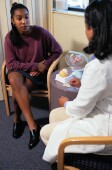
TUESDAY, May 8 (HealthDay News) — Nearly half of the counties in the United States lack a single obstetrician-gynecologist, a situation that may worsen as medical school graduates gravitate toward metropolitan areas, a new study indicates.
More than 9.5 million Americans live in areas without obstetrician-gynecologists (ob-gyns); this scarcity is more prevalent in rural pockets of the country, and particularly in the Midwest and South. However, some experts feel the spotty distribution of these specialists — who assist in the births of 4 million babies each year and tend to the reproductive health of millions of women — isn’t necessarily a problem.
“If there’s not an obstetrician in one county, but there’s one in the next county, then it may not affect patient care at all,” said Dr. Erin Tracy, an ob-gyn at Massachusetts General Hospital in Boston, who was not involved in the study. “It’s a striking statistic . . . but I’m not sure how it affects actual access to care.”
The study, authored by University of New Mexico researcher Dr. William Rayburn, is scheduled for presentation Tuesday at the American College of Obstetricians and Gynecologists (ACOG) annual meeting in San Diego.
Rayburn and his colleagues gathered data from the 2010 U.S. County Census File for adult and reproductive-age women and from the ACOG membership roster. They found that about 33,300 ob-gyns were practicing in the United States in 2010, representing 5 percent of a total of 661,400 physicians.
The average number of ob-gyns per 10,000 women dropped significantly from counties with cities in them to those with smaller towns and rural areas. Forty-nine percent of the country’s 3,143 U.S. counties lacked a single ob-gyn, the investigators found.
“You’re going to get less of every [medical] specialty, the more rural you get. That’s going to be true across the board,” explained Dr. Jill Rabin, chief of ambulatory care, obstetrics and gynecology, and head of urogynecology at Long Island Jewish Medical Center in New Hyde Park, N.Y.
“But generally you can find, within a reasonable driving distance, someone using cutting-edge technology,” Rabin added. “I can’t tell you that’s true in every instance, but there are ob-gyns practicing in significant proportions in small- or mid-size towns.”
The study authors wrote that the uneven distribution of ob-gyns may worsen as newly graduated medical residents cluster in metropolitan areas, and they suggested that the government offer incentives to lure physicians to underserved areas.
But Rabin noted that some government programs already exist to pay for medical training for doctors who agree to serve in designated rural areas. Also, some family practitioners in these areas deliver babies, “so they take up the slack for us,” she said.
The data and conclusions of research presented at medical meetings should be viewed as preliminary until published in a peer-reviewed journal.
More information
The U.S. Bureau of Labor Statistics has more information about employment for ob-gyns.

